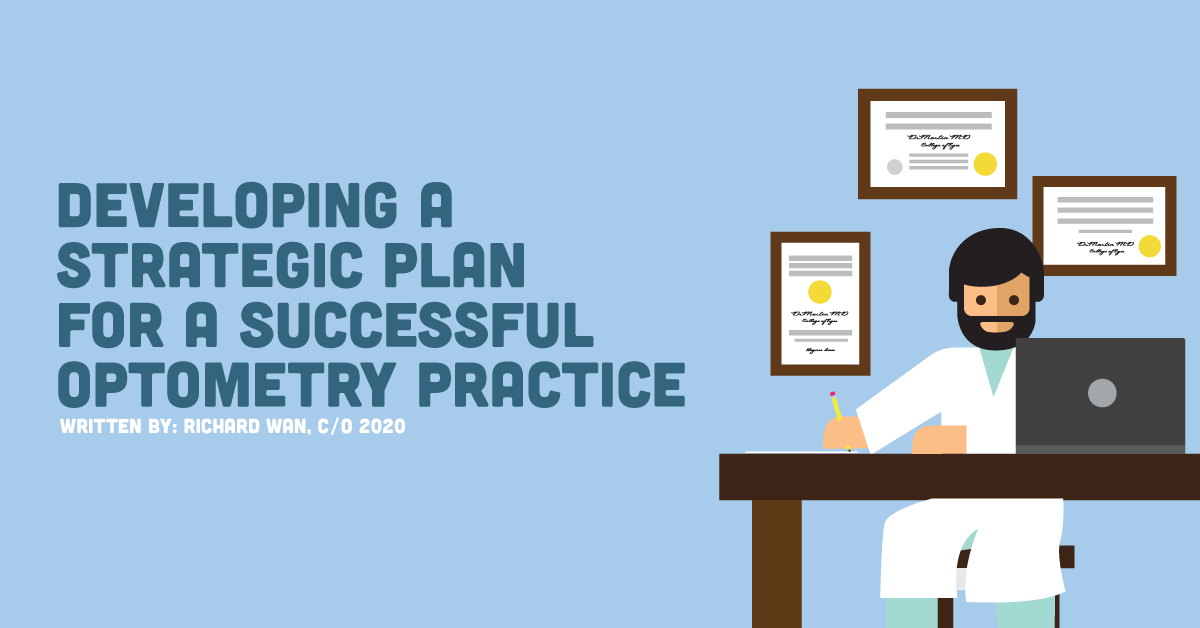So, you just graduated from optometry school, passed all of your boards, and are ready to start your own practice you’ve been dreaming of for what felt like forever, huh?
Before you plunge into a new chapter in your life, you need to sit down and figure out your game plan. People typically think having a business plan is good enough, but a strategic plan is a crucial tool that allows your practice as a whole to veer toward a clear, mutual goal.
If your “game plan” was to just open a practice and provide “high-quality medical services” and “excellent customer service,” your business will not thrive.
The optometric industry today is a lot more dynamic and unfortunately, it’s not as simple as opening an optical and making big bucks anymore. With the growth of corporate chains, e-commerce services and distributors, and competition among private practices, the competitive environment has become more and more profound.
So, what can you do to make sure you’re making the right decisions when running a practice?
The root of it comes from developing a strategic plan.
When developing a strategic plan, an owner must ask him or herself the following questions:
- How will my practice create value?
- How will my practice capture value?
- How will my practice sustain value?
At first glance, this may seem obvious and unnecessary; however, if you take the time to explicitly define them, when the time comes to make important decisions, it will be clear which options will drive you toward your goal and which will deter you.
Business is like chess, you need to take the time to analyze your (and your opponent’s) moves and counter them. Your strategic plan should also be flexible and adapt with your environment.
Bottom line, by asking yourself these questions, you ultimately can define how your business can create and sustain a competitive advantage, which is what allows a business in any industry to thrive among multiple competitors. Over the long run, the difference in the success among practices often boils down to their ability to effectively position themselves in an evolving landscape to gain leverage.
After you answered the questions above, you need to determine what unique resources and capabilities you have that can be utilized to achieve superior and sustained profits for your business. The more you can identify and convey to your patients, the higher they will be willing to pay.
If you are able to create and sustain differentiation with whatever you focus on compared to your competitors, you will have a source of competitive advantage.
Please do not try to “differentiate” by offering the lowest price. Because of online alternatives and corporate chains, you will rarely ever win in a pricing war and the result will be slim profit margins until you go out of business. Your goal should be to provide service that is valuable to the buyer beyond simply offering a low price.
Customer Service
A strong way to justify premium prices is by offering superior customer service. This is a great attribute ALL businesses should have. However, every specific process, and I mean EVERY single detail under this broad category, needs to be analyzed and perfected.
Even if you go into detail on training your staff to provide excellent customer service, your scope of service can be too myopic and should expand to a deeper level of engagement. That means you need to listen to your staff and respect their voice if you want them to reciprocate and build engagement toward your strategy. This also expands to customer feedback and maintaining customer service performance. Other things, including excellent post-sale customer service, speedy, on-time delivery, and a unique selling experience are all examples of ways you can differentiate your practice.
Drivers of Uniqueness
Other areas for differentiation, such as service features and performance, complementary services, specialized machinery, skill and experience of employees, having better stocked shelves, and bundling and offering a combination of complementary products and services can make your practice unique. One common advantage nearly all private practices can exploit is superior flexibility and avoiding motivational and coordination issues that corporate organizations often face.
A consumer’s willingness to pay a premium price often comes from an emotional or intangible dimension, whether it is the trust associated by an established practice or the status associated with the optometrists so this can really be used as strategic leverage against corporate chains.
Cost Advantage Strategy
Although the strategic goal in the optometric private sector is to obtain a premium price through differentiation, optimizing operational costs can contribute to higher margins and profitability. The cost advantage might come from lower operating costs and using capital efficiently. Think about the direct operating and asset costs, overhead costs, and reducing service errors. Ask yourself what specific costs could be cut if you stopped performing this activity. By following these steps, you should step toward better operational effectiveness in comparison to competitors.
When all these isolated mechanisms are combined, it makes it difficult for competitors to imitate you. By following the steps given in this article and constantly asking yourself how you can create, capture, and sustain value, you should have a clearer understanding of what you can do to make your practice stand out from the crowd and succeed. Be innovative and think outside the box and enjoy running your business.
Got a great strategic plan? Ready to grow your practice? Watch this discussion between Matt Geller, OD, and Brett Kestenbaum, DPT of CovalentCareers, Inc. for more insight on when, why, and how to hire optometrists for your practice.
